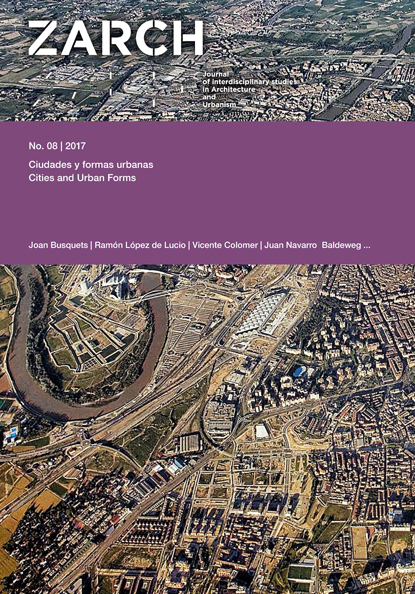Principios de la forma urbana en el trabajo de Leslie Martin y el LUBFS | Principles of the urban form in the work of Leslie Martin and the LUBFS
DOI:
https://doi.org/10.26754/ojs_zarch/zarch.201782154Abstract
La revisión de la arquitectura moderna suscitada en el ámbito británico durante los años cincuenta y sesenta supone uno de los referentes para entender la evolución del pensamiento arquitectónico durante la segunda mitad del siglo XX. Uno de los temas de mayor alcance fue el esfuerzo por desarrollar nuevos principios de la forma urbana y superar algunas limitaciones de la ciudad moderna. El papel de Leslie Martin tuvo especial trascendencia tanto en la práctica como en el ámbito académico como director de la Escuela de Arquitectura de Cambridge y del grupo LUBFS (Land Use and Built Form Studies). Su trabajo, además de un modo singular de entender la ciudad, refleja algunas de las cuestiones más relevantes debatidas en este contexto. Del mismo modo que la comprensión de los aciertos y fracasos de propuestas urbanas como las de Leslie Martin permiten entender la deriva fragmentaria que toma posteriormente la reacción postmoderna, también posibilitan una base para repensar la ciudad contemporánea.PALABRAS CLAVE: Forma urbana, trama, espacio urbano, densidad, geometría.
The review of modern architecture raised in Britain during the fifties and sixties became a reference to understand the evolution of the architectural thought during the second half of the twentieth century. One of the most discusses subject was the effort to develop new principles of urban form and overcome some limitations of the modern city. The role of Leslie Martin was particularly significant both in practice and in the academic field as director of The Cambridge School of Architecture and the LUBFS (Land Use and Built Form Studies). His work, in addition to a unique way of understanding the city, reflects some of the most relevant topics discussed in this context. In the same way that the understanding of the successes and failures of urban proposals such as those of Leslie Martin allow us to understand the postmodern fragmentary reaction, they also provide a basis to rethink the contemporary city.
KEYWORDS: Urban form, Grid, Urban space, Density, Geometry.
Downloads
Download data is not yet available.
Downloads
Published
2017-10-02
Issue
Section
Topic papers
How to Cite
De Esteban Garbayo, J. (2017). Principios de la forma urbana en el trabajo de Leslie Martin y el LUBFS | Principles of the urban form in the work of Leslie Martin and the LUBFS. ZARCH. Journal of Interdisciplinary Studies in Architecture and Urbanism, 8, 170-183. https://doi.org/10.26754/ojs_zarch/zarch.201782154





